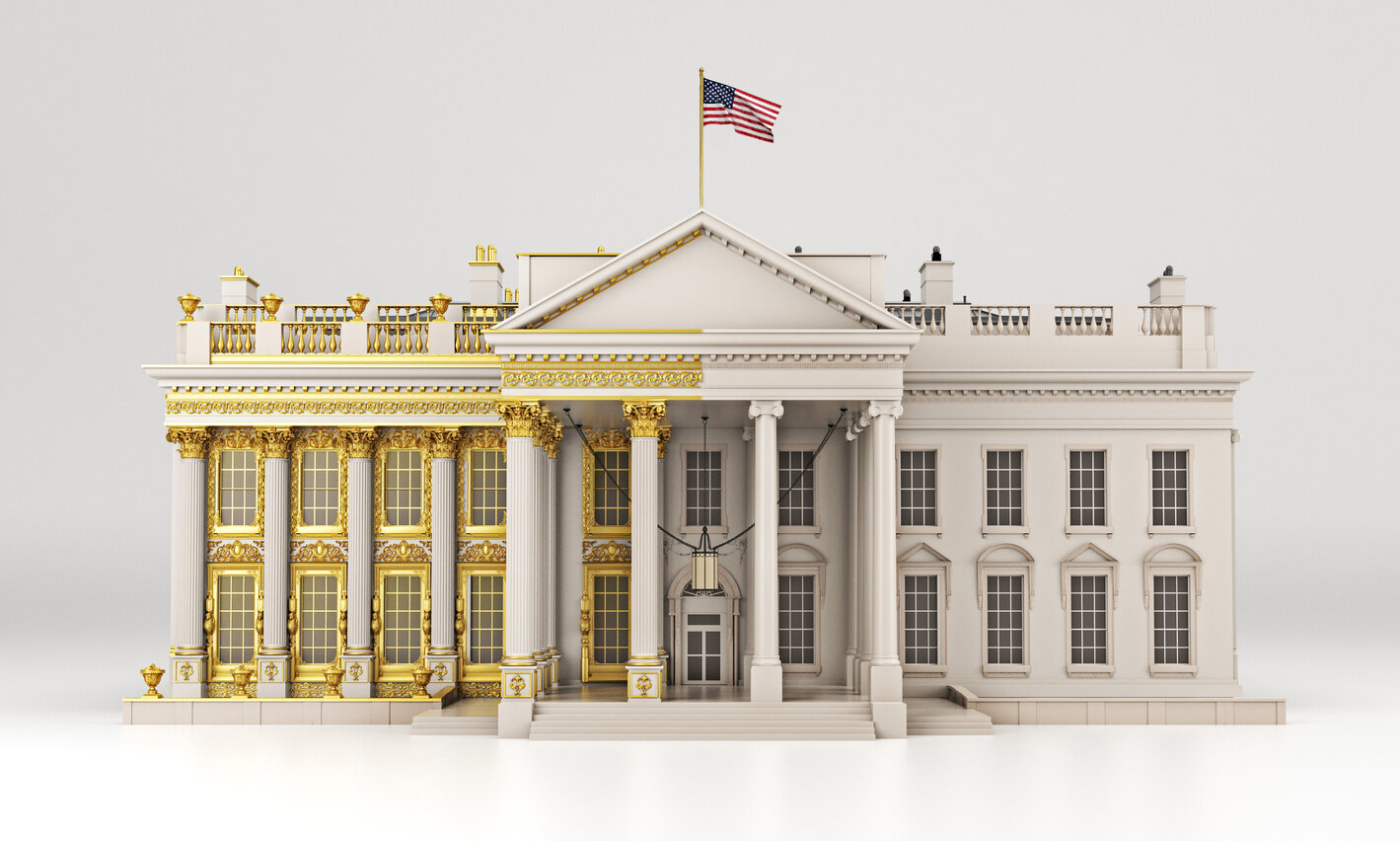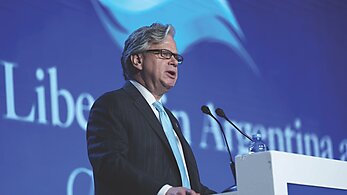Illustrations by Pablo Declan and HITANDRUN
Cult of the Presidency: America’s Pathological Relationship with Executive Power
Relentless growth in executive power has turned the president into an extraconstitutional figure, capable of forcibly settling America’s most divisive issues with the stroke of a pen.
n the waning days of the George W. Bush administration, I wrote a book called The Cult of the Presidency: America’s Dangerous Devotion to Executive Power. In it, I made the case that for far too long, Americans have looked to the presidency for far too much. Our political culture has invested the office with preposterously vast responsibilities, I argued, and as a result, the officeholder wields powers that no one fallible human being ought to have.
Turns Out, It’s Worse than I Thought
At the time, I thought it was a suitably dark and pessimistic take. So it’s disorienting to look back, a decade and a half down the road, and realize the book wasn’t nearly dark and pessimistic enough.
In the intervening years, the “most powerful office in the world” has grown more powerful still: The presidency of 2024 is even more autocratic and menacing than the presidency of 2008. At the same time, the moral and intellectual quality of the applicant pool has declined dramatically from an already abysmal base. When America sends people to the presidency, we’re not sending our best.
My colleagues in the books department at Cato looked out upon our ongoing national nightmare and perceived a marketing opportunity—a chance to put Cult’s themes in front of a new set of readers. They pressed me to update the book for a fall release (“Just when I thought I was out, they pull me back in!”), and I submitted the manuscript the first week of June. Here’s how the new preface originally described the 2024 state of play:
This coming November, we face the second matchup between a man who ginned up a riot hoping to intimidate Congress into overturning the results of an election he’d lost, and a sundowning octogenarian whom 69 percent of Democrats consider “too old to effectively serve.” Little wonder, then, that according to a 2023 voter survey, the most prevalent sentiment in this election cycle is “dread” (41 percent), followed by “exhaustion” (34 percent). Toward the end of Cormac McCarthy’s novel Suttree, the ne’er-do-well protagonist, having lately recovered from a barfight skull fracture followed by a bout of typhoid fever, muses to himself: “There are no absolutes in human misery and things can always get worse.” So here we are.
That last bit still holds true, but the rest of the passage has obviously been overtaken by events. First, on June 27, a stumbling, shambolic debate performance laid bare the extent of President Biden’s decline. Then, as pressure mounted on Biden to withdraw, the nation watched former president Donald Trump survive an assassination attempt by mere inches, thanks to a chance turn of the head. Eight days later, in a cryptic note released via the social media platform X, President Biden announced his decision to bow out. In a follow-up post half an hour later, he endorsed Vice President Kamala Harris for the Democratic nomination. At this writing, the outcome of the 2024 contest remains radically uncertain, but dread and exhaustion persist.
Fifteen years and three presidencies since Cult was released, it’s worth taking stock of what’s changed and what hasn’t in America’s pathological relationship with the presidency—if only to gird ourselves for fresh horrors to come. The persistence of presidential cults and the growth of executive power were predictable—and predicted in The Cult of the Presidency. And yet, in the years since I wrote the book, American politics went feral to an extent I didn’t foresee.
The rise of mass partisan hatred, or what’s recently been dubbed “political sectarianism,” has raised the stakes of our political differences dramatically and made the president’s burgeoning power a direct threat to social peace. The presidency itself has become a central fault line of polarization because the president, increasingly, has the power to reshape vast swaths of American life.
American Idolatry
When I wrote the book, I fancied myself ripping the veil off what we’d let the office become, rubbing our noses in our creepy, idolatrous orientation toward the modern presidency. The president described in the Federalist was to have “no particle of spiritual jurisdiction.” Yet American political culture has invested the role with quasi-mystical significance, turning a limited, constitutional officer into a figure responsible for all things great and small—from the price of a tank of gas to the state of the “national soul.” This “vision of the president as national guardian and redeemer,” I wrote in Cult’s opening pages, has become “so ubiquitous
it goes unnoticed.”
Lately, though, it’s all getting a bit too on the nose. The upcoming election is a “Battle for the Soul of the Nation,” President Biden proclaimed in a prime-time address delivered from the steps of Philadelphia’s Independence Hall—a crusade against the MAGA-hatted forces of “chaos,” who “live not in the light of truth but in the shadow of lies.”
Actually, it’s even more apocalyptic than that, insists former president Trump: “2024 is our Final Battle,” he thundered at his campaign’s kickoff rally in Waco, Texas, where an armed standoff in 1993 between federal agents and cult leader David Koresh ended with over 80 dead: “For those who have been wronged and betrayed … I am your warrior, I am your justice … I am your retribution.” “God Made Trump” goes the refrain of a campaign ad the ex-president posted on Truth Social earlier this year: “And on June 14th, 1946, God looked down on his planned Paradise, and said, I need a caretaker. So God gave us Trump,” the narrator intones.
The former president’s courage under fire on July 13—and the unforgettable photograph it produced, showing his fist raised with the American flag billowing behind—breathed new life into the notion of Trump as a God-touched man of destiny. Even the New York Times briefly got into the spirit, declaring that the Associated Press’s iconic snapshot “made Trump the incarnation of defiance” and comparing it to the iconic Iwo Jima photograph and Eugène Delacroix’s Liberty Leading the People, a painting in which a woman embodying France raises a flag in her right arm.
Vice President Harris has up till now served as punchline material: a figure nearly as incoherent and rambling as President Biden, without the excuse of age. Yet Democratic partisans are determined to meme a “Cult of Kamala” into existence, with social media images depicting her as Wonder Woman, Captain America, and the Statue of Liberty.
Even so, if we take a longer view, there’s reason to doubt either cult will have lasting mass appeal. The mystique of the presidency has taken a well-deserved hit in recent years, thanks in no small part to Trump himself. With his insult-comic pep rallies, open contempt for legal limits—broadcast over a Twitter feed that resembled a table read of the Watergate tapes—and general inability to act like a grown-up in a grown-up’s job, the 45th president “sanded the faux majesty off the office and freed the masses to direct their worship to other, more credible gods,” Politico’s Jack Shafer wrote in 2017, “as long as he remains a prisoner of his impulses … we can look forward to seeing the prestige of the office decline.”
Decline it has, at least in terms of the trust Americans invest in the executive branch, which, according to recent numbers by Gallup, has fallen to within three points of its record post-Watergate low. But in contrast to the post-Watergate era, renewed distrust hasn’t yet translated into reforms that re-limit presidential power. The forced march through the Barack Obama, Trump, and Biden presidencies left Americans somewhat less romantic and more jaded about the office’s potential as a wellspring of national redemption. But each of those men managed to seize new powers, leaving the office stronger than it was when they found it.
The Incredible Expanding Presidency
Of the three presidencies we’ve endured since Cult came out in 2008, Obama’s looms largest, both in terms of the messianic, revival-tent atmosphere surrounding him—and his aggressive expansion of executive power.
As a candidate, Obama had pledged to “turn the page on the imperial presidency.” But by the time he hit the podium at Oslo to accept his precipitously awarded Nobel Peace Prize in December 2009, Obama had already launched more drone strikes than George W. Bush managed in eight years. He’d leave office as the first two-term president in American history to have been at war every day of his presidency.
Along the way, our 44th president did more than any predecessor to strip away the remaining legal limits on presidential warmaking. Less than a year after his Peace Prize acceptance, Obama launched his first “war of choice,” in Libya. When the Qaddafi regime failed to collapse on schedule, Obama defied the limits imposed by the 1973 War Powers Resolution on the novel theory that you’re not engaged in “hostilities” if the foreigners you’re bombing can’t hit you back. And it was Obama who was largely responsible for warping the 2001 Authorization for Use of Military Force—passed three days after 9/11 to target al Qaeda and the Taliban—into an enabling act for endless war anywhere in the world. In September 2011, he added yet another innovation, the remote-control execution of a US citizen, far from any battlefield. And in the summer of 2013, thanks to National Security Agency whistleblower Edward Snowden, the public learned that the administration had been engaged in a massive secret effort to collect domestic phone data, targeting Americans in the name of protecting them from terrorism.
Even where no national security claim was available, Obama managed to forge new frontiers in the abuse of executive power at home. Throughout his second term, he increasingly governed by executive fiat. “I’ve got a pen, and I’ve got a phone,” the president bragged, and he proceeded to use them to unilaterally grant lawful status and eligibility for federal benefits for nearly half of the 11 million unauthorized immigrants in the country; invent a presidential “power of the purse,” spending billions of dollars Congress never appropriated on health care subsidies; and issue regulatory “guidance” documents strong-arming colleges and universities into growing their diversity, equity, and inclusion bureaucracies and tightening restrictions on campus speech.
In private, Obama was heard to worry that his executive-power innovations would lie around like a “loaded weapon” for future presidents to abuse. And on January 20, 2017, he passed that fearsome arsenal on to Trump, who used it aggressively and added a few new inventions of his own.
The most dangerous of these came in January 2020, when Trump used the targeted-killing machinery set up by George W. Bush and perfected by Obama to eliminate Iranian general Qassem Soleimani. The Soleimani hit was something new: It marked the first time an American president publicly ordered the assassination of a top government official for a country we’re not legally at war with. It was also a major usurpation of congressional power: Killing a senior government figure with a drone-fired missile is something every country on Earth would consider a declaration of war, a decision our Constitution reserves for Congress.
Trump’s other key innovation was in the use of presidential emergency powers. In February 2019, he declared a national emergency in order to “build the wall” on the US-Mexico border, diverting over $5 billion to a pet project Congress had refused to support. It seems not to have occurred to any president before Trump that he could use a bogus “emergency” claim to do an end run around Congress in a budget battle. Yet that’s precisely what President Trump did, and Congress proved powerless to stop him.
Then, in early 2020, a genuine national emergency arrived, in the form of the COVID-19 outbreak. In terms of lives lost and economic damage, the pandemic rapidly eclipsed the two prior crises of the 21st century: 9/11 and the financial panic of 2008. In a welcome if unexpected development, Trump broke from the pattern of past presidents, declining to exploit the emergency to seize new powers. COVID-19 proved to be one crisis President Trump was willing to let go to waste.
Instead, it was his successor, Joe Biden, who seized on the pandemic to justify rule by decree, ordering Americans to mask up on public transport, forbidding landlords to collect the rent, and mandating that workers show their COVID-19 vaccination cards in order to keep their jobs. By early 2022, it had become clear that, in the name of public health, the Biden administration had been engaged in a massive covert effort to suppress political speech. As the Twitter Files and related litigation would reveal, “very angry” Biden officials had pushed social media companies to blacklist and shadowban alleged disinformation (much of it actually accurate) about the COVID-19 lab-leak theory, pandemic lockdowns, and COVID-19 risk.
Perhaps inspired by his predecessor’s emergency-power creativity, in August 2022, President Biden announced a plan to cancel up to $600 billion in student loan debt for some 43 million borrowers, using a 2003 emergency-power statute aimed at providing relief to US soldiers then deployed in Iraq and Afghanistan. The Supreme Court rebuffed the plan, ruling that it exceeded the authority granted in the statute. Undeterred, the administration is mining new sources of statutory authority in the hopes of delivering another multibillion-dollar jubilee prior to November’s election.
Meanwhile, as these three presidents expanded the office’s power to reshape American life and law, something else was happening that made centralized control more dangerous. Americans were growing so far apart they could barely understand—or stand—one another anymore.
The Cult in the Age of Political Sectarianism
The first two decades of this century marked the dawn of “an acute era of polarization,” the Stanford political scientists Shanto Iyengar and Masha Krupenkin report, one in which “partisans’ mild dislike for their opponents has been transformed into a deeper form of animus.”
A key measure of partisan hostility is the so-called feelings thermometer, a long-running series of surveys in which respondents rate their own party and the other party on a temperature scale of 1 to 100. In the 1970s, Democrats and Republicans rated their own party a balmy 74 degrees and the opposing party a slightly brisk 48 degrees. By 2020, however, the average temperature rating for the other side had plummeted to a bitter 20 degrees.
Increasingly, Americans aren’t just cold to the other team: They hate and fear them. Majorities of highly politically engaged Republicans (62 percent) and highly politically engaged Democrats (70 percent) tell pollsters that the other party makes them feel “afraid.” Politics now divides Americans more than race, sex, or religion. In fact, in disturbing ways, politics has taken the place of religion.
In the fall of 2020—midway between the lockdown and Black Lives Matter summer and the Capitol riot on January 6, 2021—a group of leading polarization scholars proposed reframing the phenomenon in religious terms. What’s come over us is best described as “political sectarianism,” they argued, characterized by “strong faith in the moral correctness and superiority of one’s sect.” Like the Sunni and Shia in the Middle East and Catholics and Protestants in Northern Ireland, large numbers of politically engaged Americans have come to see their political opponents as “alien,” “contemptible,” and “iniquitous.”
As recently as 2016, the idea that the other team was morally debased was a minority view among partisans, but by 2022, the Pew Research Center reports, 72 percent of Republicans and 63 percent of Democrats had come to regard members of the other party as “more immoral.” And in a 2019 study entitled “Lethal Mass Partisanship,” researchers found that over 42 percent of Republicans and Democrats agreed with the statement that members of the other party “are not just worse for politics—they are downright evil.” When asked “Do you ever think: we’d be better off as a country if large numbers of [opposing party] in the public today just died?,” 15 percent of Republicans and 20 percent of Democrats owned up to occasionally wishing mass death on fellow Americans who don’t vote the same way they do.
“There is a religious war going on in this country,” Pat Buchanan proclaimed in a notorious speech at the 1992 Republican National Convention. The pundit class recoiled in horror at the time, but it looks as if Buchanan’s dark prophecy was just slightly ahead of the trend. The cult of the presidency persists, and Americans have become increasingly desperate to prevent the ascendancy of the rival sect. “Viewing opposing partisans as different, dislikable, or immoral, may not be problematic in isolation,” the authors of “Political Sectarianism in America” write, but “when all three converge, political losses can feel like existential threats that must be averted—whatever the cost.”
A Divider, Not a Uniter
Here’s a thought experiment: If you had to design institutions from scratch to govern such a deeply divided people, how would you proceed? The prudent answer, it seems to me, is as gently as possible.
Where having one national policy is unavoidable—as in trade or war—you’d favor elected representatives in multiple branches of government deliberating and forging consensus. Otherwise, to preserve social peace, you’d want contentious issues settled close to home, where there’s more common ground. The last thing you’d want to do is maximize the number of zero-sum, one-size-fits-all decisions made at the top, with one man making the call.
Instead, over the past couple of decades, we’ve been running a dangerous experiment. As our politics took on a quasi-religious fervor, we’ve been concentrating vast new powers in the executive branch. Fundamental questions of governance that used to be left to Congress, the states, or the people are now increasingly settled—winner take all—by whichever party manages to seize the presidency.
In all the hand-wringing over polarization, law professors John McGinnis and Michael Rappaport warn in an important 2022 article, “Presidential Polarization,” that a key factor “has gone largely undiscussed: the deformation of our federal governing structure.” The drift toward one-man rule both intensifies partisan fury and makes it more dangerous.
Where the original constitutional design required broad consensus for broad policy changes, “now the president can adopt such changes unilaterally,” McGinnis and Rappaport write, and whenever the presidency changes parties, “rules affecting almost every aspect of American life will pivot 180 degrees, as the White House changes hands.”
When one person decides what your health insurance covers, whether or not you’re on the hook for your student loans, whether we have a trade war with China or a shooting war with Iran—when so much turns on who holds the White House, it’s a safe bet we’re going to fight about it bitterly. The modern presidency is by its very nature a divider, not a uniter. It’s become far too powerful to be anything else.
Culture Warrior in Chief
Worse still, as national harmony has frayed, recent presidents have used their burgeoning powers to pick at the seams. In the years since Cult was published, the weapons of presidential power have increasingly been deployed to impose forced settlements on the issues that divide us most. In the age of identity politics, the modern president has become our culture warrior in chief.
Earlier battles in America’s perennial “culture wars” were rarely fought with the pen and phone. Presidents weighed in on flashpoint issues of the time, like school prayer, abortion, and family values, but their efforts were largely performative. In the 1980s and 1990s, presidential culture-warring was mainly waged from the bully pulpit.
If a president wanted to signal that he was really serious about a particular culture-war dispute, he’d throw his weight behind a constitutional amendment designed to settle the issue. In 1982, for example, President Ronald Reagan proposed a school-prayer amendment; in 1989, President George H. W. Bush backed another prohibiting flag desecration. Lip service and long-shot constitutional amendments remained the key tactics in presidential culture-warring at the time I began writing Cult. In the 2004 and 2006 election cycles, President George W. Bush proclaimed his support for a Federal Marriage Amendment defining marriage as “a union of man and woman.” Like the school-prayer and flag-burning amendments, it sputtered out well before reaching the goal line.
Throughout this whole period, no president seemed to imagine that he could wade into culture-war fights and settle them with the stroke of a pen. Perhaps the only culture-war executive order of note was one first issued by Reagan in 1985, requiring US foreign aid recipients to certify that they wouldn’t perform or promote abortion as a method of family planning. Starting with President Bill Clinton, subsequent Democratic presidents turned the “Mexico City policy” off—and Republicans, on again—with the requirement winking in and out of existence each time the office changed parties, without meaningfully affecting any American’s rights.
But in the 15 years since The Cult of the Presidency was published, the consequences of a shift in party control of the office have grown far more sweeping. Few issues divide Americans more than race; nevertheless, one of Joe Biden’s first acts as president was to issue an executive order guaranteed to divide us further. On his first day in office, Biden issued the Executive Order on Advancing Racial Equity that makes rooting out systemic racism a central organizing principle for the federal government, mounting a frontal assault on equality before the law. In 2021, for example, the Biden administration began handing out emergency COVID-19 relief funds—debt relief for farmers, grants to restaurants—on an explicitly racial basis. That principle even extended to lifesaving drugs. Minority status alone could move you to the front of the line for COVID-19 antivirals in states following guidelines from Biden’s Food and Drug Administration.
On the contentious issue of transgender rights, once again, what the country’s getting is forced settlement through unilateral edict and administrative order. Title IX of the Education Amendments Act of 1972 prohibits discrimination “on the basis of sex” in any program receiving federal financial assistance. New Title IX regulations by the Biden Education Department in April make the president the commander in chief of the girls’ room, empowered to decide which kid gets to use which bathroom in practically every K–12 public school and college in America. In May, the Department of Health and Human Services finalized a rule requiring doctors and hospitals to provide gender-affirming care—puberty blockers, cross-sex hormones, and “top” and “bottom” sex-change surgeries—including for minor children. Private insurers—and the taxpayer, via Medicaid—will be required to foot the bill.
It seems there’s no contested social issue too parochial to escape the notice of the culture warrior in chief. Lately, the Biden-Harris administration has been hell-bent on making a federal case out of how local school districts curate their grammar school library shelves. At the White House Pride Celebration in June 2023, the president announced the appointment of a “book-ban coordinator” in the Education Department’s Office for Civil Rights: “We’re taking on these civil rights violations, because that’s what they are,” Biden told the crowd. If local taxpayers decide Maia Kobabe’s cartoon-porn memoir Gender Queer is too hot for the bookmobile, they may have to face a federal inquisition over creating a “hostile environment” for LGBTQ students.
If he wins in November, Trump has no intention of declaring a federal ceasefire. Instead, his Agenda 47 campaign website promises to arm the other side of these culture-war battles. He’ll take the Office for Civil Rights off the book-ban beat and sic them on any teacher who covers critical race theory or transgender issues or forces “other inappropriate racial, sexual, or political content on children.” They’ll face “severe consequences” under federal civil rights law. What the Biden-Harris administration calls “gender-affirming care,” Trump deems “child sexual mutilation” and promises to use federal health care dollars to dictate the proper medical treatment for gender dysphoria from the White House. He’ll task the Justice Department with investigating pharmaceutical companies that make puberty blockers and push for a law “prohibiting child sexual mutilation in all 50 states.” No doubt he’ll encourage some creative prosecutions when he discovers the federal Female Genital Mutilation law that’s already on the books.
The Most Important Election in History?
One of the key benefits of “energy in the executive,” Alexander Hamilton argued in the Federalist, is that it would provide “steady administration of the laws.” In the modern era, it’s had the opposite effect: The law changes radically from administration to administration, depending on the policy preferences of the president. In the service of presidential culture-warring, puberty blockers and so-called gender-affirming care can go from compulsory to forbidden every four to eight years depending on which political party wins the presidency. And on a host of other controversial policies—from immigration to racial preferences to energy and the environment—“energy in the executive” now means whipsawing between extremes whenever power changes hands.
“In the last decade,” the New York Times reported in April, “environmental rules in particular have been caught in a cycle of erase-and-replace whiplash,” making it nearly impossible for industries to plan. New tailpipe emissions restrictions issued by the Biden Environmental Protection Agency in March are designed to “ensure that the majority of new passenger cars and light trucks sold in the United States are all-electric or hybrids by 2032,” and regulations finalized in April will force coal plants “to either deploy technology to capture virtually all their emissions, or shut down.” Here, too, Trump promises another 180-degree turn.
Partisans have always told us that next November’s is the most important election in history; we used to take it with the requisite grain of salt. In 2000, only 45 percent of Americans told pollsters it really mattered who won that year’s presidential contest. It went up from there: 63 percent in 2012,
74 percent in 2016, and 83 percent in 2020.
Maybe Americans think it matters because, increasingly, it matters. If everything from what car you can buy to what books go on grammar school library shelves turns on which party controls the White House, good luck convincing people to take an electoral loss in stride.
“The imperial administrative presidency,” McGinnis and Rappaport note, “raises the stakes of any presidential election, making each side fear that the other will enjoy largely unchecked and substantial power in many areas of policy.” That fear encourages the dangerous sentiment that every election is a Flight 93 election—charge the cockpit, do or die. The relentless growth of executive power has made the presidency itself a central catalyst of social strife.
Americans have an inchoate sense that something’s amiss: A majority of voters recognize that our “system of checks and balances … is not working well these days,” according to a recent survey by the Associated Press and the University of Chicago. “The abstract idea of a president with nearly unchecked power remains unpopular,” for what that’s worth, which is not much. The rub comes when we go from the abstract to the particular. The Associated Press summed up the survey results succinctly: “Americans think a president’s power should be checked—unless their side wins.”
Yet anyone capable of thinking past a single presidential election cycle should recognize the dangers of giving presidents an even freer hand. In a country as fractious as ours has become, that’s a prescription for turning our as-yet-metaphorical civil war into real American carnage.
We should be heading in the opposite direction, limiting the damage presidents can do and lowering the stakes of presidential elections—reining in emergency powers, war powers, authority over trade, and the ability to make law with the stroke of a pen. Our most pressing need is for structural reforms that limit the harm we might do to one another amid the fog of partisan war.
I wrote Cult because I believed the American presidency had become an extraconstitutional monstrosity and a libertarian nightmare, “the source of much of our political woe and some of the gravest threats to our liberties.”
The last decade and a half has given me little reason to change that assessment. But as I look back at what I wrote then, I fear that I understated the dangers we’d face by failing to re-limit executive power. In certain passages, I seem to suggest that the wages of constitutional sin would be … frustration, an eternal recurrence of the “timeworn pattern: outsized expectations, dangerous centralization of power, and inevitable failure,” a “perennial cycle of disappointment and centralization.”
Fifteen years later, the risks strike me as far more dire than that. In our partisan myopia, we’ve unwittingly laid down the infrastructure for autocratic rule and sectarian warfare. The danger isn’t that we’ll wind up disappointed; it’s the prospect that the presidency will tear the country apart.
It’s said that God protects fools, drunks, and the United States of America. But it is also written: “Thou shalt not tempt the Lord thy God.” Just how far do we want to keep pressing our national luck?






